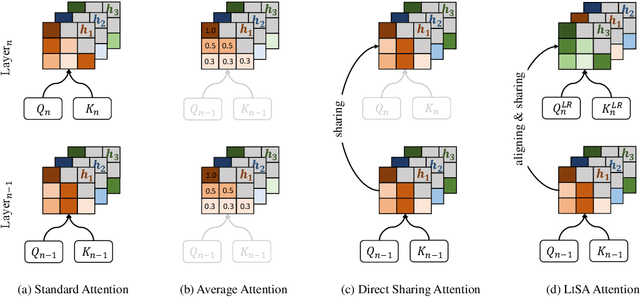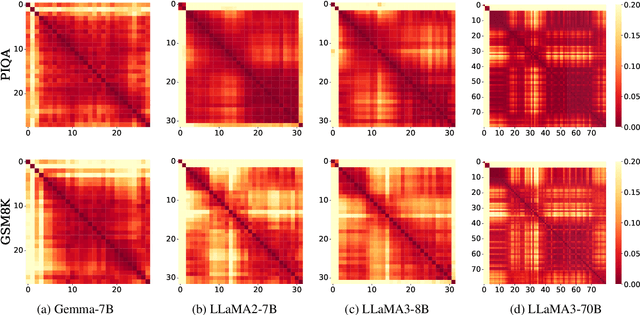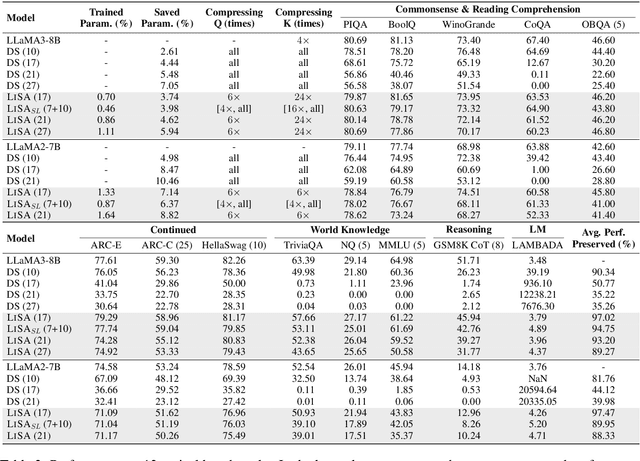Yongyu Mu
GRAM: A Generative Foundation Reward Model for Reward Generalization
Jun 18, 2025Abstract:In aligning large language models (LLMs), reward models have played an important role, but are standardly trained as discriminative models and rely only on labeled human preference data. In this paper, we explore methods that train reward models using both unlabeled and labeled data. Building on the generative models in LLMs, we develop a generative reward model that is first trained via large-scale unsupervised learning and then fine-tuned via supervised learning. We also show that by using label smoothing, we are in fact optimizing a regularized pairwise ranking loss. This result, in turn, provides a new view of training reward models, which links generative models and discriminative models under the same class of training objectives. The outcome of these techniques is a foundation reward model, which can be applied to a wide range of tasks with little or no further fine-tuning effort. Extensive experiments show that this model generalizes well across several tasks, including response ranking, reinforcement learning from human feedback, and task adaptation with fine-tuning, achieving significant performance improvements over several strong baseline models.
Dissecting Long Reasoning Models: An Empirical Study
Jun 05, 2025Abstract:Despite recent progress in training long-context reasoning models via reinforcement learning (RL), several open questions and counterintuitive behaviors remain. This work focuses on three key aspects: (1) We systematically analyze the roles of positive and negative samples in RL, revealing that positive samples mainly facilitate data fitting, whereas negative samples significantly enhance generalization and robustness. Interestingly, training solely on negative samples can rival standard RL training performance. (2) We identify substantial data inefficiency in group relative policy optimization, where over half of the samples yield zero advantage. To address this, we explore two straightforward strategies, including relative length rewards and offline sample injection, to better leverage these data and enhance reasoning efficiency and capability. (3) We investigate unstable performance across various reasoning models and benchmarks, attributing instability to uncertain problems with ambiguous outcomes, and demonstrate that multiple evaluation runs mitigate this issue.
Beyond Decoder-only: Large Language Models Can be Good Encoders for Machine Translation
Mar 09, 2025Abstract:The field of neural machine translation (NMT) has changed with the advent of large language models (LLMs). Much of the recent emphasis in natural language processing (NLP) has been on modeling machine translation and many other problems using a single pre-trained Transformer decoder, while encoder-decoder architectures, which were the standard in earlier NMT models, have received relatively less attention. In this paper, we explore translation models that are universal, efficient, and easy to optimize, by marrying the world of LLMs with the world of NMT. We apply LLMs to NMT encoding and leave the NMT decoder unchanged. We also develop methods for adapting LLMs to work better with the NMT decoder. Furthermore, we construct a new dataset involving multiple tasks to assess how well the machine translation system generalizes across various tasks. Evaluations on the WMT and our datasets show that results using our method match or surpass a range of baselines in terms of translation quality, but achieve $2.4 \sim 6.5 \times$ inference speedups and a $75\%$ reduction in the memory footprint of the KV cache. It also demonstrates strong generalization across a variety of translation-related tasks.
Boosting Text-To-Image Generation via Multilingual Prompting in Large Multimodal Models
Jan 13, 2025Abstract:Previous work on augmenting large multimodal models (LMMs) for text-to-image (T2I) generation has focused on enriching the input space of in-context learning (ICL). This includes providing a few demonstrations and optimizing image descriptions to be more detailed and logical. However, as demand for more complex and flexible image descriptions grows, enhancing comprehension of input text within the ICL paradigm remains a critical yet underexplored area. In this work, we extend this line of research by constructing parallel multilingual prompts aimed at harnessing the multilingual capabilities of LMMs. More specifically, we translate the input text into several languages and provide the models with both the original text and the translations. Experiments on two LMMs across 3 benchmarks show that our method, PMT2I, achieves superior performance in general, compositional, and fine-grained assessments, especially in human preference alignment. Additionally, with its advantage of generating more diverse images, PMT2I significantly outperforms baseline prompts when incorporated with reranking methods. Our code and parallel multilingual data can be found at https://github.com/takagi97/PMT2I.
SLAM: Towards Efficient Multilingual Reasoning via Selective Language Alignment
Jan 07, 2025Abstract:Despite the significant improvements achieved by large language models (LLMs) in English reasoning tasks, these models continue to struggle with multilingual reasoning. Recent studies leverage a full-parameter and two-stage training paradigm to teach models to first understand non-English questions and then reason. However, this method suffers from both substantial computational resource computing and catastrophic forgetting. The fundamental cause is that, with the primary goal of enhancing multilingual comprehension, an excessive number of irrelevant layers and parameters are tuned during the first stage. Given our findings that the representation learning of languages is merely conducted in lower-level layers, we propose an efficient multilingual reasoning alignment approach that precisely identifies and fine-tunes the layers responsible for handling multilingualism. Experimental results show that our method, SLAM, only tunes 6 layers' feed-forward sub-layers including 6.5-8% of all parameters within 7B and 13B LLMs, achieving superior average performance than all strong baselines across 10 languages. Meanwhile, SLAM only involves one training stage, reducing training time by 4.1-11.9 compared to the two-stage method.
LRHP: Learning Representations for Human Preferences via Preference Pairs
Oct 06, 2024



Abstract:To improve human-preference alignment training, current research has developed numerous preference datasets consisting of preference pairs labeled as "preferred" or "dispreferred". These preference pairs are typically used to encode human preferences into a single numerical value through reward modeling, which acts as a reward signal during reinforcement learning from human feedback (RLHF). However, representing these human preferences as a numerical value complicates the analysis of these preferences and restricts their broader applications other than RLHF. In contrast, in this work, we introduce a preference representation learning task that aims to construct a richer and more structured representation of human preferences. We further develop a more generalizable framework, Learning Representations for Human Preferences via preference pairs (namely LRHP), which extends beyond traditional reward modeling to tackle this task. We verify the utility of preference representations in two downstream tasks: preference data selection and preference margin prediction. Building upon the human preferences in representations, we achieve strong performance in both tasks, significantly outperforming baselines.
RoVRM: A Robust Visual Reward Model Optimized via Auxiliary Textual Preference Data
Aug 22, 2024



Abstract:Large vision-language models (LVLMs) often fail to align with human preferences, leading to issues like generating misleading content without proper visual context (also known as hallucination). A promising solution to this problem is using human-preference alignment techniques, such as best-of-n sampling and reinforcement learning. However, these techniques face the difficulty arising from the scarcity of visual preference data, which is required to train a visual reward model (VRM). In this work, we continue the line of research. We present a Robust Visual Reward Model (RoVRM) which improves human-preference alignment for LVLMs. RoVRM leverages auxiliary textual preference data through a three-phase progressive training and optimal transport-based preference data selection to effectively mitigate the scarcity of visual preference data. We experiment with RoVRM on the commonly used vision-language tasks based on the LLaVA-1.5-7B and -13B models. Experimental results demonstrate that RoVRM consistently outperforms traditional VRMs. Furthermore, our three-phase progressive training and preference data selection approaches can yield consistent performance gains over ranking-based alignment techniques, such as direct preference optimization.
Cross-layer Attention Sharing for Large Language Models
Aug 04, 2024



Abstract:As large language models (LLMs) evolve, the increase in model depth and parameter number leads to substantial redundancy. To enhance the efficiency of the attention mechanism, previous works primarily compress the KV cache or group attention heads, while largely overlooking redundancy between layers. Our comprehensive analyses across various LLMs show that highly similar attention patterns persist within most layers. It's intuitive to save the computation by sharing attention weights across layers. However, further analysis reveals two challenges: (1) Directly sharing the weight matrix without carefully rearranging the attention heads proves to be ineffective; (2) Shallow layers are vulnerable to small deviations in attention weights. Driven by these insights, we introduce LiSA, a lightweight substitute for self-attention in well-trained LLMs. LiSA employs tiny feed-forward networks to align attention heads between adjacent layers and low-rank matrices to approximate differences in layer-wise attention weights. Evaluations encompassing 13 typical benchmarks demonstrate that LiSA maintains high response quality in terms of accuracy and perplexity while reducing redundant attention calculations within 53-84% of the total layers. Our implementations of LiSA achieve a 6X compression of Q and K, with maximum throughput improvements of 19.5% for LLaMA3-8B and 32.3% for LLaMA2-7B.
Translate-and-Revise: Boosting Large Language Models for Constrained Translation
Jul 18, 2024Abstract:Imposing constraints on machine translation systems presents a challenging issue because these systems are not trained to make use of constraints in generating adequate, fluent translations. In this paper, we leverage the capabilities of large language models (LLMs) for constrained translation, given that LLMs can easily adapt to this task by taking translation instructions and constraints as prompts. However, LLMs cannot always guarantee the adequacy of translation, and, in some cases, ignore the given constraints. This is in part because LLMs might be overly confident in their predictions, overriding the influence of the constraints. To overcome this overiding behaviour, we propose to add a revision process that encourages LLMs to correct the outputs by prompting them about the constraints that have not yet been met. We evaluate our approach on four constrained translation tasks, encompassing both lexical and structural constraints in multiple constraint domains. Experiments show 15\% improvement in constraint-based translation accuracy over standard LLMs and the approach also significantly outperforms neural machine translation (NMT) state-of-the-art methods.
Hybrid Alignment Training for Large Language Models
Jun 21, 2024Abstract:Alignment training is crucial for enabling large language models (LLMs) to cater to human intentions and preferences. It is typically performed based on two stages with different objectives: instruction-following alignment and human-preference alignment. However, aligning LLMs with these objectives in sequence suffers from an inherent problem: the objectives may conflict, and the LLMs cannot guarantee to simultaneously align with the instructions and human preferences well. To response to these, in this work, we propose a Hybrid Alignment Training (Hbat) approach, based on alternating alignment and modified elastic weight consolidation methods. The basic idea is to alternate between different objectives during alignment training, so that better collaboration can be achieved between the two alignment tasks.We experiment with Hbat on summarization and dialogue tasks. Experimental results show that the proposed \textsc{Hbat} can significantly outperform all baselines. Notably, Hbat yields consistent performance gains over the traditional two-stage alignment training when using both proximal policy optimization and direct preference optimization.
 Add to Chrome
Add to Chrome Add to Firefox
Add to Firefox Add to Edge
Add to Edge